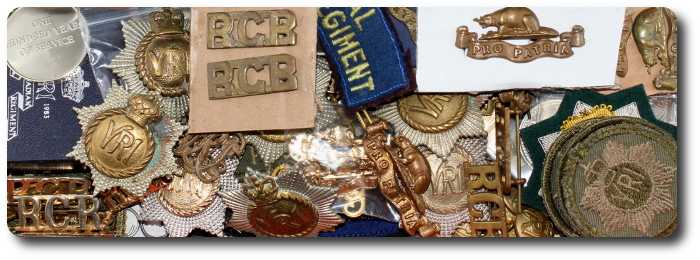
Badges of The Royal Canadian Regiment
Crowns, Cyphers and Controversy
By Capt Michael O'Leary, The RCR
(This article was published in the Regimental Journal of The RCR; Pro Patria 2007)
Errors overlooked by the staff, decades of 'disobedience', the seeking of influence . . . all good elements of drama in military intrigue, or the story of a Regiment's badges. Royal Canadians have worn one form or another of the eight-pointed star since the Regiment's creation as the Infantry School Corps. From our own Catechism and regimental indoctrination we know of our granted authority to wear the "VRI" in perpetuity from 1919, but few know of the circumstances and behind-the-scenes activities which led to this notable and unique privilege.
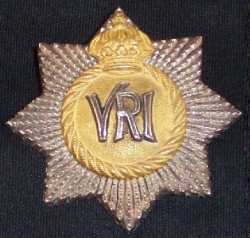
The 1894 Guelphic crown pattern badge worn by The RCR between 1894 and 1919. This image shows an officers' pattern badge with silver letters over a gilt centrepiece. Photo: Capt M. O'Leary (private collection)
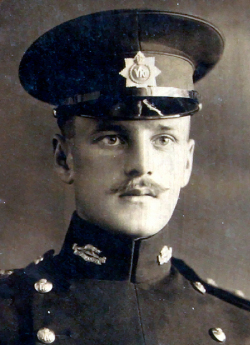
In this photo dated 1910, Lt R.O. Alexander is clearly wearing a "VRI" badge while the official badge of the Regiment was supposed to be that of King Edward VII. Lt Alexander, later Brigadier, would serve with The RCR from 1910 to 1935 and received the Distinguished Service Order and three Mentions in Despatches during the Great War. Photo: The RCR Museum.
How many different cap badges have been produced for the Regiment? No one actually knows. The major variations of our cap badge are easily identified. But the minor variations, in detail of design, colours, materials, mounting hardware, etc., provide a seemingly endless variety. The RCR Museum has over 40 different regimental cap badges in its display in the Centennial Gallery. My own collection, at the time of this writing, holds over 80 different regimental badges. While there is considerable overlap between the two collections, each also includes badges not found in the other, so even 100 different badges may be a low estimate for the number of distinct RCR cap badges in existence.
In 1883, when the Infantry School Corps was authorized, badges were created for the use of the Corps. This included the helmet plate, Glengarry badges, and an eight-pointed star, most likely for use on the field service cap (wedge cap in modern parlance). Each of these types is represented in the Regimental Museum, and the single 1883 eight-pointed star in the museum's Early Years gallery is the only one known to me at this time. It is not confirmed if this badge was produced in any numbers and worn widely by the Regiment.
That early badge, however, is not the one that features most prominently in this article. It was in 1894, when new badges for our Regiment were approved, that we find the beginning of the most complex and intriguing story of our badges.
With the right to wear the Royal cypher on our accoutrements granted by Her Majesty Queen Victoria, our badges, buttons and shoulder titles were all redesigned. Authorized by Militia General Order 35 of May 1894, these orders described the approved "Forage Cap Badge" as:
"A silver eight-pointed star, with a raised gilt circle same as for centre of the helmet plate, but in proportion, the Royal and Imperial cypher (V.R.I.) in frosted gilt, surmounted by the Imperial Crown, dimensions of the star, 2 inches."
Seems quite clear does it not? But who might have expected problems with the approved "Royal and Imperial cypher (V.R.I.) in frosted gilt, surmounted by the Imperial Crown." And yet, problems did ensue, which would exist for over three decades. The crown produced on the badge approved in 1894 for forage caps and other headdress (i.e., other than the helmet of the era) did not even have an Imperial Crown in its design. The crown was a Hanoverian crown (also known as a Guelphic crown). This was not a British crown at all, and, in fact, the design is considered to be Germanic in origin.
The Regiment wore this badge from its first issue in 1894 until 1901, when the story of the Regiment's badges took another turn after the death of Her Majesty Queen Victoria. Traditionally, on the death of the sovereign, unit and corps badges which include the reigning sovereign's cypher in their design are automatically 'updated' to include the cypher of the new King or Queen. While this was done with regard to the officially authorized badges of the Regiment, at least as far as the Militia Department was concerned, it was obviously not a welcome change within the Regiment. The Regiment neither completely accepted nor adhered to the letter of the regulation in the following decades.
While documentary evidence of early applications to retain the "VRI" are unknown, photographic evidence of officers wearing the Victorian encyphered badges clearly show that these remained in use during the reign of Edward VII (1901-1911) and the early part (1911-1919) of the reign of George V. Within the early part of the 20th Century the Regiment now not only continued to wear a heraldically incorrect badge design but also openly wore badges which, after the death of Queen Victoria, were no longer the officially authorized regimental badge.
From 1901 until 1911, the authorized pattern for regimental cap badges included the cypher of King Edward VII. These badges also included the change to the Tudor Crown. Known colloquially among collectors as the "King's Crown", this nomenclature is not technically correct as individual British Crowns are not gender specific.
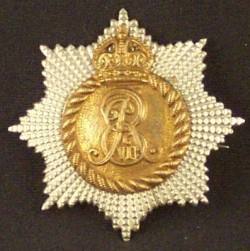
The 1901 Tudor-crown badge with the Royal Cypher of His Majesty King Edward VII. This was the official regimental badge between 1901 and 1910. Photo: Capt M. O'Leary (private collection)
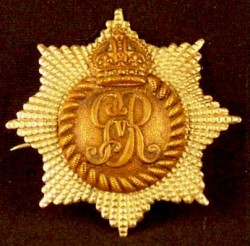
The 1911 Tudor-crown badge with the Royal Cypher of His Majesty King George V. This was the official regimental badge between 1910 and 1919. Photo: Capt M. O'Leary (private collection)
The authorized badge pattern changed again in 1911. General Order 26 of March 1911 stated:
"The Royal Cypher of His Majesty King George (G.R.V.) will supersede the Royal Cypher E.R.VII, which has hitherto been in use for regimental buttons and other dress and equipment purposes."
Leading up to the outbreak of the First World War, it is apparent from the regimental history that the Militia department was losing patience with the Regiment's continued campaign to confirm the "VRI" for its cap badges:
"Then, upon the death of Queen Victoria, His Majesty King Edward VII, in accordance with the custom in such circumstances, granted permission for the Regiment to wear his cypher. As the Regiment, however, wished to retain the V.R.I. in honour of the late Queen, a prolonged correspondence between the unit and Militia Headquarters followed, ending after eight years when Headquarters ruled that "this correspondence must now cease." Officers at the time were still wearing V.R.I. badges in some instances, but E.R.I. badges had been issued to the men. Later E. R. VII and still later G. R. V badges and buttons were issued.
"In 1912, the matter was referred to the College of Heralds and, upon the receipt of this body's opinion, Lieut.-Col. A. O. Fages, then Officer Commanding the Regiment, called for new designs. A number of drawings were accordingly submitted, but as all failed to meet the need, Militia Headquarters refused to authorize them. So matters stood in 1914 when the Great War intervened." (pp. 398-399, The Royal Canadian Regiment; 1883-1983, R.C. Fetherstonhaugh, 1936)
The Regiment in its dispersed garrisons, far from Militia Headquarters, continued to thwart the traditional change of Royal cypher for the second sovereign since the death of Her Majesty Queen Victoria. The state of badges within the Regiment in the pre-War era is described by 477869 Private Dudley Douglas Spencer in Pro Patria #24, May 1975:
"I plainly recall some sixty two years ago, when cleaning our scarlet uniforms, some badges were ER VII, some were GRV on the shoulder straps and cap badge. VRI Emblems were very scarce, but the battle continued for the granting of all ranks to wear VRI badges and buttons."
Just imagine a modern Sergeant Major facing such a mix of accoutrements on a regimental parade.
Both the ongoing battle to retain Victoria's cypher, and the attempts of the Militia Department to remove it, were no secrets. The RCR War Diary for August 1916 (Appendix XI) contains a brief regimental history for the use of officers in briefing their troops. The first paragraph includes these remarks:
"We are sometimes confused with the Leinsters who are Royal Canadians but it must be borne in mind that we are The Royal Canadians. In addition to this honour, we have other distinctions of which we are justly proud. Our buttons and cap badge have V.R.I. on them. These letters stand for Victoria Regina Imperatrix which being translated, means, Victoria Queen and Empress (of India). Now this distinctive mark was given to us by the late Queen Victoria which is one of the facts of which we are most proud. The Militia Department of Canada have always tried to take it away from us, but, in spite of all, we have retained it and we all sincerely trust that we shall continue to do so."
The regimental journal "The Connecting File" of June 1927 (Vol. VI, No. 2) includes a photograph of a crudely carved regimental badge described as "The Regimental Cap badge carved in the side of a trench in front of Vimy Ridge and brought to light by recent excavations." The carving may have been crude, but it is quite clearly a Guelphic crown badge with the VRI cypher.
The Regiment may have discontinued its determined level of correspondence over the Victorian cypher during the First World War, but the matter was certainly not forgotten. The Regimental history continues to describe the struggle once fighting ceased:
"Soon after the Armistice in 1918, Major H.T. Cock, MC, who was temporarily in command of the Expeditionary Force battalion, reopened the question and, with the permission of the Commanding Officer, wrote to Field-Marshal His Royal Highness the Duke of Connaught, Honorary Colonel of the Regiment, explaining the questions that had arisen and the Regiment's point of view. As a result of His Royal Highness's sympathetic reception of this letter and of representations made subsequently by Lieut.-Col. Hill, who lunched with him at his command, His Majesty King George V, in 1919, granted The Royal Canadian Regiment the right to wear in perpetuity the cypher V.R.I." (pp. 399, The Royal Canadian Regiment; 1883-1983, R.C. Fetherstonhaugh, 1936)
The long sought decision granted by His Majesty King George V was published in General Orders in 1919:
General Orders 1919
G.O. 53/1919
Regimental Crest--Royal Canadian Regiment
His Majesty the King has been graciously pleased to approve of the Royal Canadian Regiment retaining in perpetual use the cypher "V.R.I." on the badges and buttons of the regiment.
Col Fages, Col Seely-Smith, Capt H.T. Cock, MC; the list of regimental officers who were involved in the Regiment's long struggle to regain and retain the "VRI" included many notable names of the period. Obviously, this had long been a matter of serious regimental importance. The topic must have absorbed much personal time and energy to pursue something that was significantly counter to tradition, and also unprecedented.
Problem solved, right? Well, not quite. The regimental history puts it succinctly:
"This decision settled one point, but there remained the difficulty in regard to the incorrect crown." (pp. 399, The Royal Canadian Regiment; 1883-1983, R.C. Fetherstonhaugh, 1936)
With the King's approval of the right to wear "VRI", the old (and probably some not so old) 1894 pattern badges could now be worn without being in contravention of Militia Orders. Also, by the King's order, the tradition of changing cyphers with each sovereign was set aside for the Regiment henceforth. But that one element of long standing error remained, the badges still sported the Guelphic crown over the "VRI" insignia.
In November, 1924, Major E.A. Seely-Smith, then commanding the Regiment, described the situation as follows:
"The badges and buttons issued to the Regiment bear a crown which is not the Imperial Crown of any period, which appears to lack any sort of sanction and which is not British."
The following month this observation was refined in a memorandum by Major H.T. Cock
"1. In May 1894 Queen Victoria gave permission for the Royal Canadian Regiment to bear her Royal cypher as a badge.
The badge at present worn was designed at and approved by Militia Headquarters.
The Militia List showed the badge of the Regiment as:- "The Royal cypher V.R.I. ensigned with the Imperial Crown".
2. In 1902 the cypher of Queen Victoria was replaced by that of King Edward and later by that of H.M. King George. In 1913 some correspondence took place between an officer of the Regiment and the Inspector of Regimental Colours, Sir Henry Farnham Burke, of the College of Heralds, regarding the restoration of Queen Victoria's cypher. It then transpired that the badge originally approved by Militia Headquarters was not correct:-
(a) the crown was not the Imperial Crown of England but a Crown somewhat like a Hanoverian crown. It was however similar to that worn in the reign of King William IV and continued up to 1902 by many British Regiments.
(b) the cypher was the Imperial and not the Royal cypher (i.e.) V.R.I. instead of V.R. - further it was not the approved design, the letters being blocked and serrated, instead of entwined.
The reason the V.R.I. was taken as a badge was on account of it being considered correct in the case of Dominions."
So the errors, it transpired, included not only the crown, but also the letter-form of, and the inclusion of the "I" in, the royal cypher. It is, perhaps, a wonder that the right to wear "VRI" was ever granted in light of the compounding of heraldic and staff errors at the time of the original design in 1894 and the length of time over which these errors were maintained.
The final stamp of acceptance by the Militia Department on the King's decision in 1919 came a few years later. In January 1924 the decision was made and published to scrap the remaining stocks of RCR cap badges ensigned with the cyphers of the Kings.
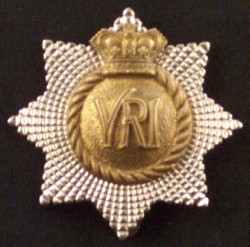
The St Edward's crown badge of The RCR, designed in 1926 to replace the Guelphic crown pattern badges still in use. This type of crown was worn continuously until the 1970s, and reappeared on recent badge issues in the 1990s. Photo: Capt M. O'Leary (private collection)
With one victory under the Regiment's belt in regaining Royal authority to wear Queen Victoria's cypher, the battle to remedy the crown was taken up again. Correspondence in 1924 and 1925 between Lieut.-Col. Seely-Smith and the Militia Department pursued this amendment to the Regiment's badges. Finally, in December 1925, on the authority of Major-General E.C. Ashton, Quartermaster-General, permission was granted:
"Adverting to your [file number] 47-4-4 of the 29th October 1925, please note that the recommendation for the change of design of the crown on the badges and buttons for the R.C.R. is approved. However, it is not proposed to provide dies and tools for new badges etc., until the existing stocks of these articles for R. and F. [Rank and File] are used up, but the necessary action will be taken when new supplies are required."
With this authority in hand, the Regiment undertook the creation and issue of two badge designs in 1926-27. These employed British crowns in two different patterns; the Imperial Crown, and the St. Edward's Crown.
As late as December 1925, "The Connecting File" still featured an 1894 pattern badge on its cover (Vol. 4, No. V). By December, 1926, the badge shown was an Imperial Crown pattern (Vol. 5, No. IV). (The intervening three issues are unavailable so it cannot be stated at this time exactly when the change took place.)
St. Edward's Crown badges were in use from the 1920s until the 1970s, when the plastic "Stay-Brite" edition (which didn't) appeared to be a death knell for that pattern of regimental badge. This crown reappeared in the 1990s with our most recent series of badges, replacing the Imperial Crown badges then in use across the Regiment.
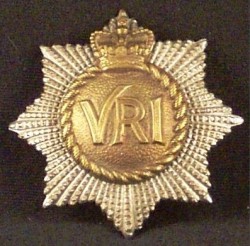
The early pattern of the Imperial crown badge of The RCR, designed in 1926 to replace the Guelphic crown pattern badges still in use. Photo: Capt M. O'Leary (private collection)
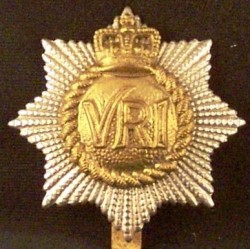
The later pattern of the Imperial crown badge of The RCR. Photo: Capt M. O'Leary (private collection)
The Imperial Crown badges, colloquially known by collectors as "Queen's Crown" badges to differentiate them from the Tudor ("King's") crown patterns, were in use from the late 1920s to the 1990s. These Imperial Crown badges are in two major groups, which can be easily told apart by the width of the base of the crown. Crowns on the earlier badges have a narrow base and, often, finer work in their production, while the later ones have a wider-based crown and can be noticeably rougher in detailing.
This very brief article has offered a glimpse of the chequered history of the heraldic elements of our Regimental badge. While The RCR has worn an eight-pointed star of one form or another since 1883, and the "VRI" since 1894, our badge's history is an interesting blend of politics, official staff work, unofficial lobbying, and outright rebellious attitudes contradicting tradition.
Despite the thorny path to the current designs, the very unique privilege of wearing the cypher of a deceased sovereign on our badges remains. Every Royal Canadian can rightly be proud of the history behind their badge and the dedication of those Royal Canadians who contributed to the effort to preserve the "VRI" for The RCR.
Pro Patria
- The O'Leary Collection; Medals of The Royal Canadian Regiment.
- Researching Canadian Soldiers of the First World War
- Researching The Royal Canadian Regiment
- The RCR in the First World War
- Badges of The RCR
- The Senior Subaltern
- The Minute Book (blog)
- Rogue Papers
- Tactical Primers
- The Regimental Library
- Battle Honours
- Perpetuation of the CEF
- A Miscellany
- Quotes
- The Frontenac Times
- Site Map
QUICK LINKS
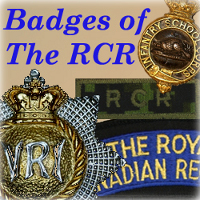
1. Introduction
2. Crowns, Cyphers and Controversy
3. Rare and Unusual Regimental Badges
4. Shoulder Flashes and Titles
1883
1894-1902, 1919-27
South African War
EviiR Badges (1902-11)
GvR Badges (1911-19)
St Edward's Crowns (1927-70s)
Maj Cock, M.C., Collection (1933)
Imperial Crowns (1926-50s)
Imperial Crowns (1960s-80s)
Dress Regs - 1960
Dress Regs - 1967
1980s
1990s
2000+
Woven Badges
Blazer Badges
Pipers' Badges
Belt Buckles
Miscellaneous
Crowns, Cyphers and Stars
RCR Headdress
Badged Brodies
Badge References